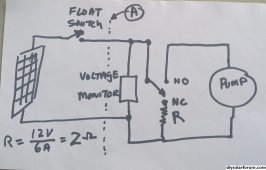Larry12
New Member
I need to make a water tank (1100 litres) with solar panels on top, and a solar powered Shurflo 12 volt water pump mounted on the bottom to send water uphill to home or livestock watering trough. This has to have an automatic shut off when solar is insufficient to run the pump.
The pump has an internal automatic shut-off when the pressure reaches 55 psi in the 1/2" output plumbing. It operates the pump again when the pressure falls below 35 psi. I want to send water up hill to another tank with a toilet type float to shut off the water when the tank gets full.
It is important on a battery-less off grid system that the pump not try to cycle when the sun is not sufficient to run it efficiently. To prevent pump overheating/failure I need something that will sense power levels and cut off all power to the pump when power is less that the required 12 volts and 6 amps DC.
I live in mountainous Costa Rica and this battery-less system will be a great boon to us. I have heard of something called "contractors" and saw these recommended for a different application. Might these work for me too? I saw some of them on Amazon ( https://a.co/d/8fQIQok ) but many reviews complained about a noisy hum and malfunctioning. I would prefer to use a reliable brand. I don't know how to hook them up either. Any knowledgeable recommendations/advice would be appreciated.
The pump has an internal automatic shut-off when the pressure reaches 55 psi in the 1/2" output plumbing. It operates the pump again when the pressure falls below 35 psi. I want to send water up hill to another tank with a toilet type float to shut off the water when the tank gets full.
It is important on a battery-less off grid system that the pump not try to cycle when the sun is not sufficient to run it efficiently. To prevent pump overheating/failure I need something that will sense power levels and cut off all power to the pump when power is less that the required 12 volts and 6 amps DC.
I live in mountainous Costa Rica and this battery-less system will be a great boon to us. I have heard of something called "contractors" and saw these recommended for a different application. Might these work for me too? I saw some of them on Amazon ( https://a.co/d/8fQIQok ) but many reviews complained about a noisy hum and malfunctioning. I would prefer to use a reliable brand. I don't know how to hook them up either. Any knowledgeable recommendations/advice would be appreciated.



